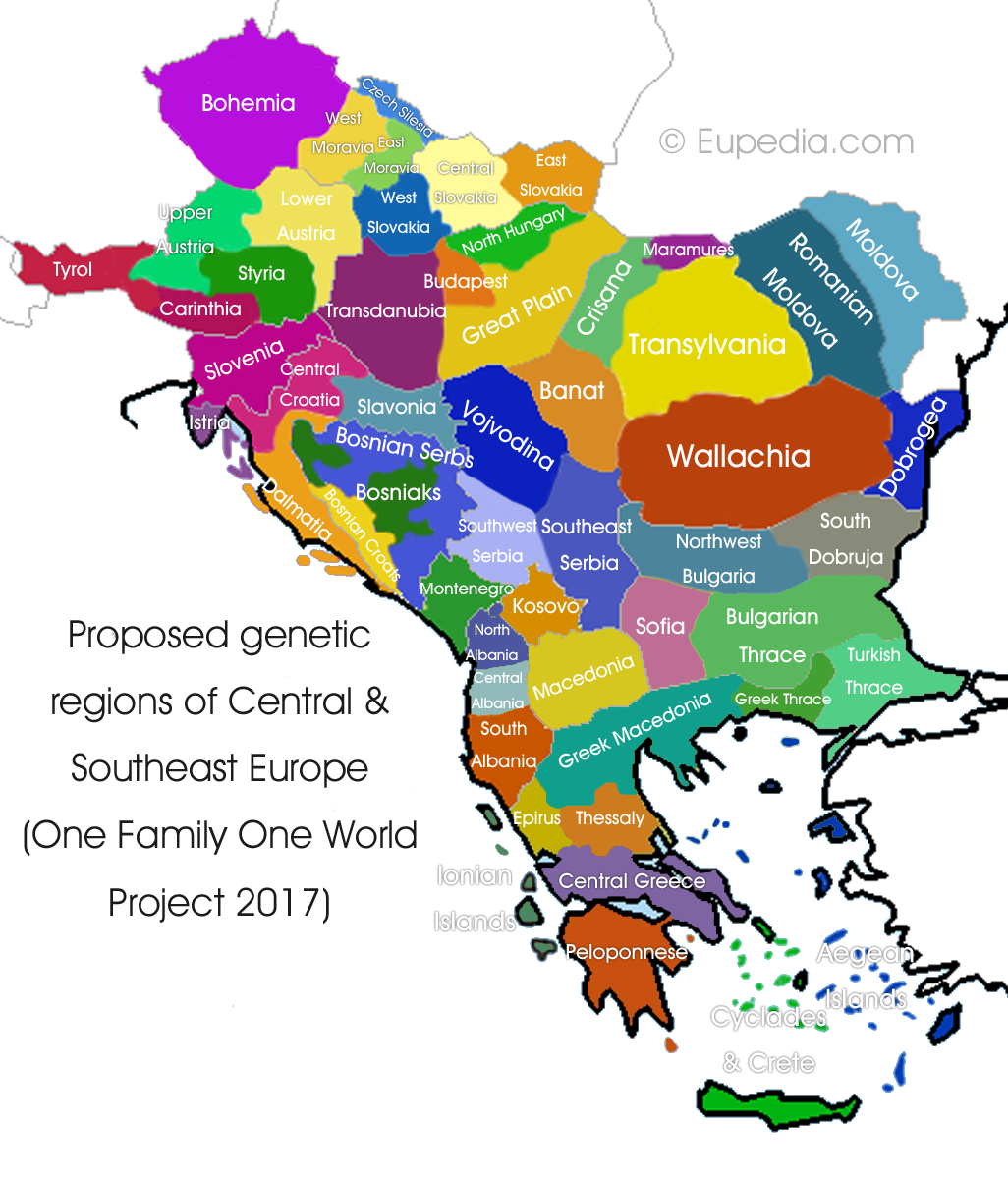One Family Project
The One Family One World Project is a partnership between Living DNA and Eupedia initiated in 2017. The project aims to map the regional genetic variations of the world with a great level of detail and accuracy in order to improve our understanding of both recent and ancient migrations and see how humans are all connected with one another as one big family.
Genetic variations within Southeast Europe
Central and Southeast Europe, a region that encompasses the Balkans, the Carpathians and the Danube basin until the Alps, has a greater ethnolinguistic diversity than any other part of the European continent.
Historical context
Ever since the first farmers colonised the region from Anatolia during the Neolithic, Southeast Europe has been the meeting point of the various ancient populations that blended with one another to form modern Europeans. Near Eastern farmers progressively intermingled with their hunter-gatherer neighbours over the course of three millennia.
In the Late Copper and Early Bronze Age, Proto-Indo-European speakers from the Pontic Steppe unfurled over the Carpathians and Balkans and followed the Danube until Austria, Czechia and southern Germany. It is once again in Southeast and Central Europe that the Steppe invaders mixed most heavily with the Late Neolithic Europeans before expanding into western Europe.
Later during the Bronze Age, a different group of people originating from the Kura-Araxes culture in South Caucasus started colonising Greece. These people are thought to have founded the Minoan Civilisation, Europe's oldest civilisation. More Steppe invasions took place during the Iron Age (Cimmerians, Scythians, Sarmatians, Huns, Alans) and the Middle Ages (Magyars, Avars, Khazars, Bulgars, Mongols), all leaving genetic traces in Southeast Europe more than anywhere else on the continent.
The Goths, Romans, Greeks, Slavs, Byzantines, Ottomans, and medieval Germans all contributed to the modern gene pool too. Nowadays many countries in the Balkans are Slavic-speaking (Slovenia, Croatia, Bosnia-Herzegovina, Serbia, Montenegro, Macedonia, Bulgaria). This is also the case of the Czech Republic and Slovakia. The Romanians and the Vlachs of other Balkanic countries speak a Romance language inherited from the Romans. The Hungarians speak an Uralic language brought by the Magyars from the Volga-Ural region. While Austrians speak a Germanic language, a lot of their DNA is shared with that of their neighbours.
Despite their linguistic differences, all these people share a considerable amount of DNA in common, inherited from the long succession of migrants to the region since Neolithic farmers set foot in Europe 8,500 years ago. How much influence did each of these historical tribes have on the genetic make-up of each modern ethnic group? Are there substantial regional difference between people speaking a same language? Help us find the answer by joining the project.
Objective & Methodology
To determine the boundaries between proposed genetic regions of Central and Southeast Europe we took into account the areas of settlements of ancient and medieval populations, and the places where the various invaders settled most heavily.
We believe that the historical borders of kingdoms and empires, the natural barriers (rivers, mountains), as well as the perimeters of the various modern dialects also influenced the way genes spread in the population over time, as people tended to marry much more frequently within the confines of their geographic, political and linguistic boundaries.
For example, Czechia was divided between the historical regions of Bohemia, Moravia and Silesia, but Moravia was also split in two to reflect the different dialects. Serbia was also divided in regions linked to the main dialects. Austria, Romania and Greece were all divided by historical regions. A combination of historical, geographic and genetic (from previous studies) elements were taken into account for other countries.
Proposed genetic regions of Central and Southeast Europe
Our preliminary research indicates at least 54 areas of Central and Southeast Europe may have distinct genetic differences.

How do I qualify?
The One Family project is open to everyone worldwide and has two parts.
- 1. To build a genetic family tree of everyone from around the world, regardless of where your family comes from.
- 2. To build a regional genetic breakdown of ancestry within countries, similar to 'The Peopling of the British Isles project'. This part of the project is looking for people with all four grandparents born within 80km (50mi) of each other inside our project areas of interest.
If you have already tested with Living DNA, all you need to do to join the project is log into your account, click on the Research tab and choose to participate in our global ancestry research project, if you haven't already done it.
If you already tested your DNA with another company (23andMe, AncestryDNA, MyHeritage, or FTDNA's Family Finder), you can join the project here for free. After submitting the form with your family information, you will receive an email to confirm the creation of your Living DNA account and will be asked to upload your genome there for free.
If you have not yet tested your DNA with one of the above companies, then you will need to order a Living DNA test to take part.
The data provided as part of the project is kept strictly private and confidential under Living DNA’s ISO:27001 certification for information security. Please read Living DNA's Privacy Policy for more information.